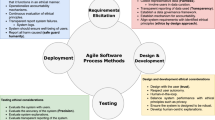Abstract
Developing healthcare monitoring apps is non-trivial as it requires a balance between simple, easy-to-use interfaces, and powerful business intelligence reporting capabilities, both of which must be integrated into the day-to-day tasks and procedures of clinical practice. This paper presents a development framework for building and deploying mobile healthcare monitoring apps. The framework combines an application development methodology (that ensures adoption and effectiveness of apps when deployed) with an application architecture and component library (to simplify and reduce the development effort needed to implement, deploy and maintain such apps). The development framework is evaluated using a case study of a mobile healthcare monitoring app developed and deployed in collaboration with a team of healthcare researchers and doctors to support the training of residents in family medicine.






Similar content being viewed by others
References
Kafeza E, Chiu D, Cheung S, Kafeza M (2004) Alerts in mobile healthcare applications: requirements and pilot study. IEEE Trans Inf Technol Biomed 8(2):173–181
Kho A, Henderson L, Dressler D, Kripalani S (2006) Use of handheld computers in medical education. J Gen Intern Med 21(5):531–537
Baarah A, Mouttham A, Peyton L (2012) Architecture of an event processing application for monitoring cardiac patient wait times. Int J Inf Technol Web Eng 7(1):1–16
Ferenchick G, Solomon D (2013) Using cloud-based mobile technology for assessment of competencies among medical students. PeerJ Inc 16(5–6):407–411
Mouttham A, Kuziemsky C, Langayan D, Ling Y, Peyton L, Pereira J (2012) Interoperable support for collaborative, mobile, and accessible health care. J Inform Syst Front 14(1):73–85
Novak L, Brooks J, Gadd C, Anders S, Lorenzi N (2012) Mediating the intersections of organizational routines during the introduction of a health IT system. Eur J Inf Syst 21(5):552–569
Johnson R (2005) J2EE development frameworks. Computer 38(1):107–110
Simitsis A, Vassiliadis P, Sellis T (2005) Optimizing ETL processes in data warehouses. In: Proceedings 21st international conference on data engineering, pp 564–575
Chamney A, Mata P, Viner G, Archibald D, Peyton L (2014) Development of a resident practice profile in a business intelligence application framework. In: 4th international conference on current and future trends of information and communication technologies in healthcare, Halifax, Canada. http://www.sciencedirect.com/science/article/pii/S1877050914010059
Leggat S, Bartam T, Stanton P (2012) High performance work systems: the gap between policy and practice in health care. J Health Organ Manag 25(3):281–297
Waterson P (2014) Health information technology and sociotechnical systems: a progress report on recent developments within the UK National Health Service (NHS). Appl Ergon 45(2):150–161
Rowley P, Gough R, Doylend N, Thirkill A Leicester P (2013) From smart homes to smart communities: advanced data acquisition and analysis for improved sustainability and decision making. In: International conference on Information Society, pp 263–268
Schmidt DC, Gokhale A, Natarajan B (2004) Leveraging application frameworks. ACM Queue 2(5):66–75
Jing-Mei L, Guang-Sheng M, Gang F, Yu-Qing M (2006) Research on Web application of struts framework based on MVC pattern. In: International workshop on advanced web and network technologies, and applications. Springer, Harbin, pp 1029–1032
Matthijssen N, Zaidman A, Storey M, Bull I, Van Deursen A (2010) Connecting traces: understanding client–server interactions in Ajax Applications. In: IEEE 18th international conference, pp 216–225
Kimball R, Ross M (2013) The data warehouse toolkit: the complete guide to dimensional modeling, 3rd edn. Wiley, New York
Gangadharan G, Sundaravalli S (2004) Business intelligence systems: design and implementation strategies. Inform Technol Interf 139–144
Vredenburg K, Mao JY, Smith PW, Carey T (2002) A survey of user-centered design practice. In: Proceedings of the SIGCHI conference on human factors in computing systems, pp 471–478
Ammenwerth E, Iller C, Mahler C (2006) IT adoption and the interaction of task, technology and individuals: a fit framework and a case study. BMC Med Inform Decis Mak 6(1):3. doi:10.1186/1472-6947-6-3
Heeks R (2005) Health information systems: failure, success and improvisation. Int J Med Inform 75(2):125–137
Fonteyn M, Kuipers B, Grobe S (1993) A description of think aloud method and protocol analysis. Qual Health Res 3:430–441
Epstein RM, Siegel DJ, Silberman J (2008) Self-monitoring in clinical practice: a challenge for medical educators. J Contin Educ Health Prof 28(1):5–13
Iglar K, Polsky J, Glazier R (2011) Using a Web-based system to monitor practice profiles in primary care residency training. Can Fam Phys 57:1030–1037
Lyman J, Schorling J, Nadkarni M, May N, Scully K, Voss J (2008) Development of a web-based resident profiling tool to support training in practice-based learning and improvement. J Gen Intern Med 23(4):485–488
LogMD. http://www.logmd.com. Accessed Apr 2015
Peffers K, Tuunanen T, Gengler C, Rossi M, Hui W, Virtanen V, Bragge J (2006) The design science research process: a model for producing and presenting information systems research. In: Proceedings of the first international conference on design science research in information systems and technology, pp 83–106
QuickForms3. https://github.com/uoForms/quickforms3. Accessed Apr 2015
Acknowledgments
This work was supported by an AIME grant from the School of Medicine at the University of Ottawa, the Mitacs Accelerate program, IBM and an NSERC Discovery Grant. We would like to thank the residents who participated in this case study, especially Alexandre Labelle. We would also like to thank Dr. Susan Humphrey-Murto and Dr. Eric Wooltorton for their participation and extremely useful feedback throughout this research.
Author information
Authors and Affiliations
Corresponding author
Rights and permissions
About this article
Cite this article
Mata, P., Chamney, A., Viner, G. et al. A development framework for mobile healthcare monitoring apps. Pers Ubiquit Comput 19, 623–633 (2015). https://doi.org/10.1007/s00779-015-0849-9
Received:
Accepted:
Published:
Issue Date:
DOI: https://doi.org/10.1007/s00779-015-0849-9




